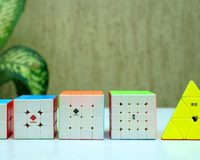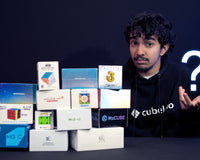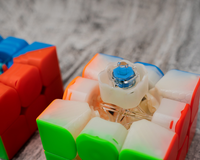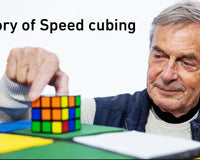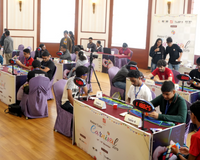Introduction
The Rubik’s Cube has come a long way since its invention in 1974. Today, the World Cube Association (WCA) recognizes 17 official events, each offering different challenges that test different skills. Let’s walk you through all these events one by one!
1. 2x2 Cube (Pocket Cube)

The 2x2 cube looks like a miniature version of the 3x3 with only corner pieces to solve.
Mechanics:
The cube consists of 8 corner pieces. Unlike the 3x3, there are no edge or center pieces.
Methods:
-
Ortega Method:
Solve one face, then orient and permute the remaining pieces.
- CLL (Corners of the Last Layer):
Solve the last layer in one algorithm, ideal for speed.
- Challenge:
Advanced-level solving requires recognition of corner permutations within milliseconds.
2. 3x3 Cube (Rubik’s Cube)

The 3x3 is the most iconic and widely recognized puzzle. It serves as the foundation for most cubing techniques.
Mechanics:
It consists of 6 fixed center pieces, 12 edge pieces, and 8 corner pieces.
Popular Methods:
- CFOP (Cross, F2L, OLL, PLL): The most widely used speedcubing method.
- Roux: Focuses on solving large blocks before orienting the remaining pieces.
- Beginner’s method: The most commonly known method among all solvers.
3. 4x4 Cube (Rubik’s Revenge)

The 4x4 cube introduces new complexities, such as multiple center pieces with the same color and paired edges, which add layers of difficulty compared to the 3x3.
Mechanics:
It has 24 center pieces, 24 edge pieces, and 8 corner pieces.
Solving Methods:
- Reduction Method: Solve the centers and pair the edges before solving it like a 3x3.
- Yau Method: Solve two centers and the cross before completing the other centers.
- Challenge: Parity errors, cases where one or two pieces are incorrectly flipped requiring specific algorithms to resolve.
4. 5x5 Cube (Professor’s Cube)

The 5x5 cube builds on the 4x4 by adding another layer, increasing the number of pieces and possible states.
Mechanics:
It has fixed centers, unlike the 4x4, along with floating centers as well and requires edge pairing of 3 different edge pieces.
- Solving Approach: Solve centers, then pair edges, and finally solve it like a 3x3.
5. 6x6 Cube

The 6x6 cube is a step up in complexity due to the increased number of pieces and potential for multiple parity errors.
Mechanics:
It features 96 center pieces, 48 edge pieces and 8 corner pieces that need to be correctly aligned.
- Challenge: Parity errors occur more frequently, as the parity algorithms used for both 4x4 and 5x5 puzzles are used in this puzzle.
6. 7x7 Cube
The 7x7 cube is the largest NxN puzzle officially recognized by the WCA.
Mechanics:
The 7x7 consists of 150 center pieces, 60 edge pieces and 8 corner pieces.
Strategy: Solve the centers first, then edges, and finally treat it as a 3x3.
7. Pyraminx
The Pyraminx is a tetrahedral puzzle that offers a different solving experience compared to traditional cubic puzzles.
Mechanics:
It consists of corner pieces, edge pieces, and center pieces that rotate independently.
Solving Techniques:
- Beginners often use a layer-by-layer method.
- Advanced solvers use methods like L4E (Last 4 Edges).
- Challenge: Fast solvers must rely on efficient finger tricks and quick recognition of patterns.
8. Megaminx

The Megaminx is a dodecahedral puzzle with 12 faces, each similar to a 3x3 but with more pieces.
Mechanics:
It consists of 5 edge stickers and 5 corner stickers, with a star-like pattern on each face.
- Solving Method: Solve layer by layer, similar to a 3x3, but with additional steps for the extra faces.
9. Skewb

The Skewb is a cubic puzzle that turns around its corners, making it feel different from traditional cubes.
Mechanics:
It consists of corner pieces and centers that rotate around the cube’s axes.
- Challenge: Its unique turning mechanism requires solvers to adapt to a different solving style in order to grip the cube better.
10. Square-1

The Square-1 can change shape during a solve, making it one of the most visually intriguing puzzles.
Mechanics:
It looks like a regular 3x3 with a middle layer that allows for half turns, sometimes resulting in a non-cubic shape.
11. Clock

The Clock is a two-sided puzzle where solvers must align nine dials on each side.
Mechanics:
Pins control the movement of the dials, and solvers must align all clocks to the 12 o’clock position.
Blindfolded Events (3BLD, 4BLD, 5BLD)

12. 3x3 Blindfolded (3BLD):
Memorize the 3x3 cube and solve it blindfolded.
13. 4x4 Blindfolded (4BLD):
Memorizing the 4x4 puzzle becomes a bit difficult as compared to the 3x3 due to the extra pieces.
14. 5x5 Blindfolded (5BLD):
Requires advanced memory techniques as a 5x5 has more than 4 times the amount of movable pieces as the regular 3x3.
15. Fewest Moves Challenge (FMC)

FMC tests a solver’s ability to solve the cube in the fewest possible moves. Participants analyze the scramble for up to an hour to find the most efficient solution.
16. One-Handed Solving (OH)

OH involves solving the 3x3 cube using only one hand.
17. 3x3 Multi-Blind (MBLD)

Multi-Blind is the ultimate test of memory. In this event, participants memorize and solve multiple 3x3 cubes blindfolded, one after the other, within a specified time limit.
Mechanics:
The solver is given a set of scrambled cubes. They have a maximum of 60 minutes to memorize all the cubes and solve them blindfolded.
- Execution: After memorization, solvers execute each cube's solution sequentially while blindfolded.
- Challenge: The event tests both memory capacity and accuracy.
Conclusion
From the simplicity of the 2x2 to the craziness of Multi-Blind, these are all of the 17 WCA events!
Happy cubing!

















